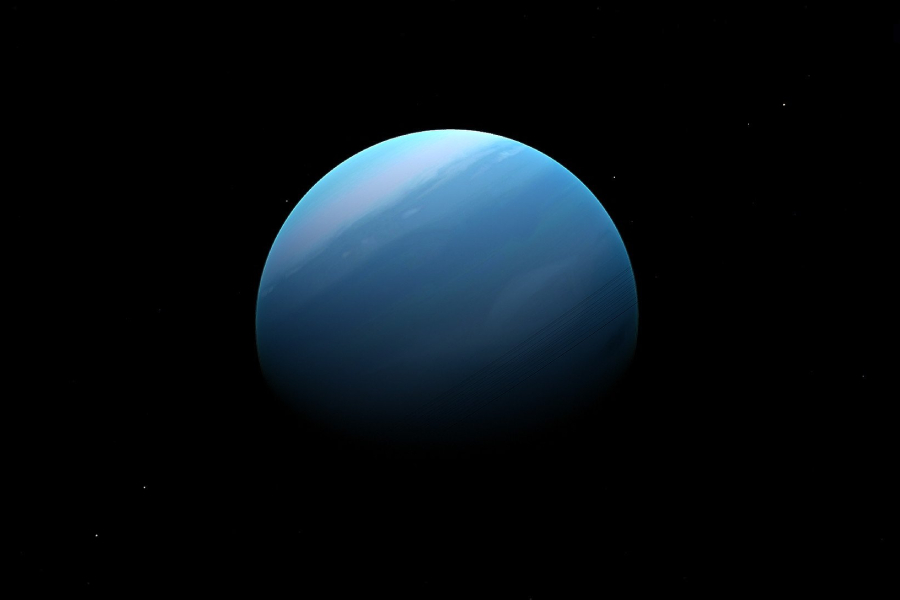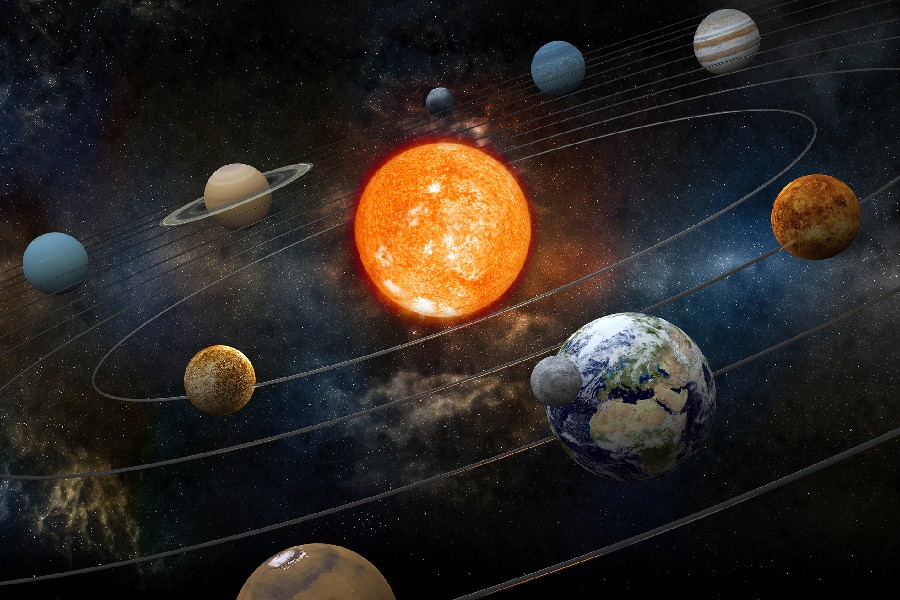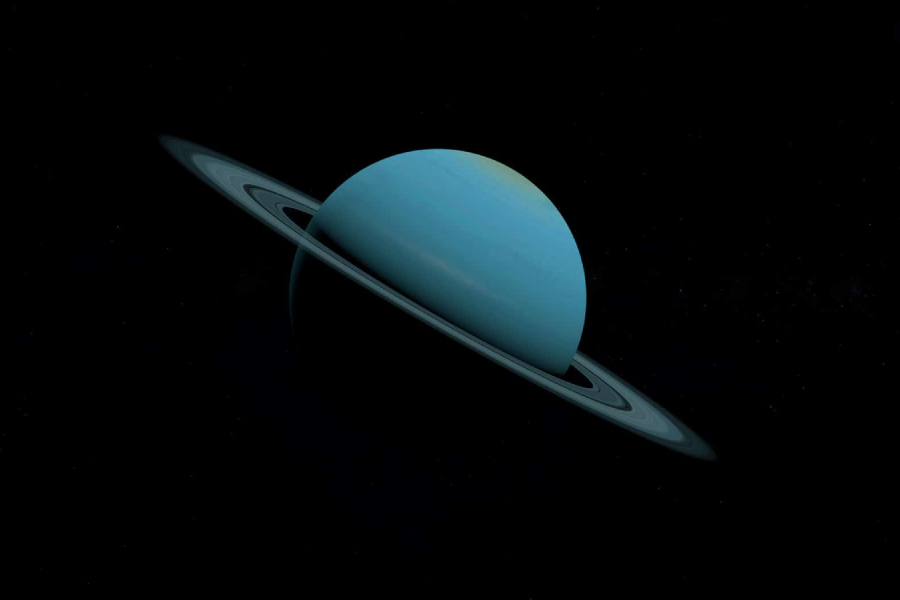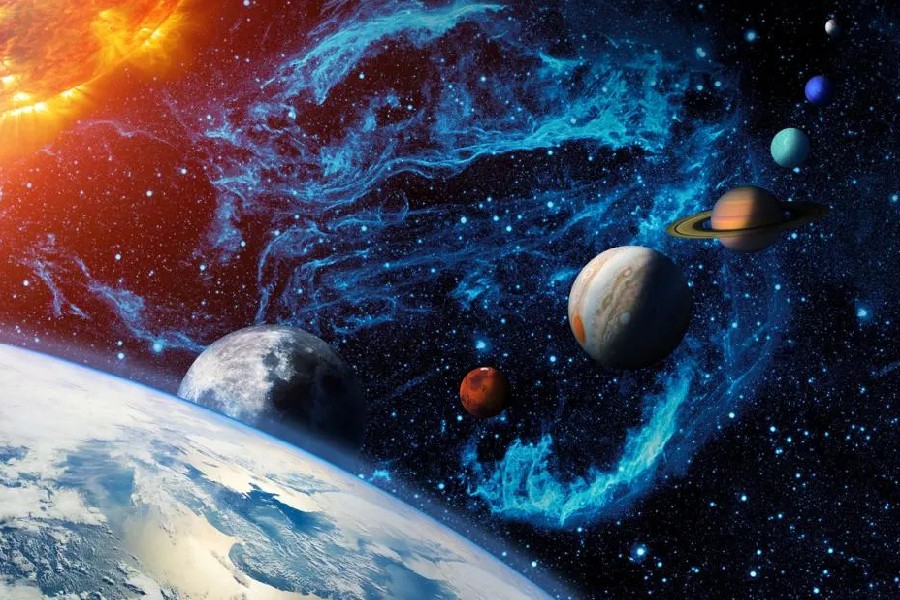Imagine gazing up at the night sky, spotting a twinkling dot of light, and wondering, is that a planet? You’re not alone; astronomers and stargazers have asked the same question about a certain celestial neighbor – Uranus. It’s a celestial body that has intrigued us for centuries, ever since it was first discovered by Sir William Herschel in 1781.
Uranus is more than just a pale, bluish dot in the heavens. Discovered in 1781 by the German-born British astronomer Sir William Herschel, Uranus was the first ice giant to be found with a telescope. Unlike most celestial objects, Uranus rotates on its side, making it roll through space like a cosmic barrel.
But the intrigue doesn’t stop at its odd orientation. Its name, derived from the Greek god of the sky, suggests its lofty significance. As we venture deeper into the story of Uranus, we will unravel the mysteries surrounding its classification and discover why the concern whether Uranus is a planet has sparked debates and scientific investigations.
So, let’s embark on a journey to unveil the secrets of this celestial enigma and decide if Uranus truly earns its place among the planets of our solar system.

Overview: Is Uranus a Planet?
So, is Uranus a planet? Yes, Uranus is indeed a planet. It is one of the eight recognized planets in our solar system and is classified as an ice giant, distinct from the gas giants like Jupiter and Saturn.
While there has been some debate about its planetary status in the past, it is now universally accepted as a full-fledged planet in our solar system. Uranus is characterized by its unique blue-green color, sideways rotation, and a fascinating system of rings and moons.
Understanding the Unique Qualities of Uranus
Uranus’s physical characteristics and location in the solar system
- Uranus is the seventh planet from the Sun and third largest in the solar system, with a radius four times wider than Earth.
- Located beyond the asteroid belt, Uranus orbits the Sun at an average distance of 1.8 billion miles, taking 84 years to complete one orbit.
- As an ice giant, Uranus has a composition of heavier elements like water, methane, and ammonia. It likely has a rocky core and icy mantle.
- The atmosphere consists of hydrogen, helium, and methane, giving Uranus its pale blue color. It has the coldest atmosphere in the solar system.
- Uranus rotates on its side, with its axis nearly parallel to its orbital plane. This causes each pole to face the Sun for 42 years during its orbit.
- Uranus has 27 moons, named after Shakespearean and Alexander Pope characters. The largest are Titania and Oberon.
Comparison of Uranus to other planets in the solar system
- Uranus is similar in composition to Neptune, both being ice giants. However, Uranus is slightly larger and has a cooler atmosphere than Neptune.
- Uranus’ blue color is more muted compared to the bright blue of Neptune. Neptune also has a more active atmosphere with visible storms and winds.
- The orientation of Uranus’ rotation is unique among planets in our solar system. All other planets rotate with slight variations relative to their orbital plane.
- Uranus experiences less internal heat and convection than Jupiter and Saturn, the gas giants. This results in a lack of cloud bands and large storms seen on Jupiter and Saturn.
- Uranus’ moons are less numerous and smaller than many of the moons orbiting Jupiter and Saturn. Triton, Neptune’s large moon, is also unique among moons in the solar system.
- The distance of Uranus from the Sun defines it as an outer solar system planet, unlike the rocky inner planets like Mercury and Mars. However, it cannot match the enormity of the gas giants Jupiter and Saturn.
The Traditional Definition of a Planet
The classical criteria for defining a planet
In the traditional astronomical framework, a celestial body qualified as a planet if it satisfied three key criteria, forming the cornerstone of planetary classification:
- Orbiting the Sun – Planets, by definition, must follow an elliptical path around the Sun, as part of our solar system.
- Sufficient mass and self-gravity – Planets should possess a significant mass, substantial enough to maintain a nearly spherical shape through self-gravity. This criterion implies that planets are large enough for their gravitational forces to overcome rigid body forces that might otherwise distort their shape.
- Clearing the neighborhood – An essential condition for planetary status involves a planet’s ability to clear its orbital neighborhood of other celestial objects. In other words, it must have the gravitational dominance to sweep away or significantly control any debris, asteroids, or smaller bodies that may share its orbital region.

How Uranus meets or fails to meet these criteria
Uranus adheres to the first two classical criteria with distinction. Firstly, it elegantly orbits the Sun, marking a fundamental characteristic of a planet. Secondly, Uranus is appropriately rounded by its own gravitational forces, achieving a nearly spherical shape – a testament to its substantial mass and self-gravity.
However, when it comes to the third classical criterion, Uranus faces a more complex evaluation. Unlike some of its planetary counterparts, Uranus has not entirely succeeded in clearing its orbital neighborhood of celestial interlopers such as asteroids or comets.
This inconclusive fulfillment of the traditional clearing requirement has been a point of contention in the ongoing debate about Uranus’s planetary classification.
The IAU’s definition of a planet
In 2006, the International Astronomical Union (IAU) introduced a redefined framework for planet classification, which incorporated the same trio of criteria as the classical definition.
To gain planetary status, according to the IAU, a celestial body must orbit the Sun, maintain self-gravity-induced roundness, and exhibit the capacity to clear its orbital vicinity of other objects. Additionally, the IAU’s definition stipulated that a planet should not serve as a moon or satellite of another celestial body.
Much like its standing in the classical definition, Uranus readily satisfies the first two criteria in the IAU’s framework. Its established solar orbit and spherical morphology leave no room for debate on these aspects.
However, Uranus continues to grapple with the challenge of fulfilling the third criterion, which demands the clearance of its orbital neighborhood. The IAU’s decision to maintain Uranus’s planetary classification despite its inability to entirely meet the clearing requirement is a testament to the exceptional nature of this celestial body.
Arguments for Uranus as a Planet
Arguments in favor of classifying Uranus as a planet
There are several reasons why Uranus is widely accepted as a planet. First, it orbits the Sun, which is a basic requirement for an object to be classified as a planet. Second, it has a near-spherical shape due to its own gravity, meeting the requirement of hydrostatic equilibrium.
Additionally, Uranus has a complex planetary geology, with differentiations between layers like a mantle, atmosphere, and potential rocky core. This fits with our understanding of a planet as a complex, layered world.
Finally, Uranus was discovered in 1781 and classified as a planet very early on in the history of astronomy, so there is a long tradition of viewing it as the seventh planet from the Sun.
Historical reasons for Uranus’s classification as a planet
When Uranus was first discovered in 1781 by William Herschel, astronomers considered it a planet almost immediately, as it was a large new object orbiting the Sun. With further observations revealing its spherical shape, size, and orbital path, its status as a planet was firmly established.
As one of only five planets visible to ancient astronomers, along with Mercury, Venus, Mars, and Jupiter, Uranus held an important place in early solar system models. While definitions of a planet have evolved over time, Uranus has remained consistently classified as a planet for over 200 years since its discovery.

Arguments Against Uranus as a Planet
Arguments against considering Uranus as a planet
Some scientists argue that Uranus does not fully meet the technical requirements to be a planet. Specifically, Uranus has not cleared its neighborhood around its orbital path. There are still thousands of objects like asteroids as well as comets in its orbit.
A planet, by definition, should have gravitational dominance that allows it to clear such objects over time. While Uranus is spherical, it does not have enough mass for its gravity to make its orbit free of hazards. Therefore, it fails to meet one of the key requirements in the International Astronomical Union’s (IAU) definition of a planet.
Challenges and controversies in classifying Uranus
The challenges with classifying Uranus highlight the controversies and evolving understanding in astronomy. Planetary scientists continue to debate questions like, what minimum size, shape, orbital path, or neighborhood clearing should be required for planet status.
Can exceptions be made in definitions for historical, cultural, or other reasons? How we classify planets also affects fields like astrobiology and the search for habitable worlds.
As astronomy advances, definitions of planets may need to be reconsidered. Uranus’s deviations from a pure planet definition force a deeper reflection on what truly makes a planet in our solar system.
The Evolving Understanding of Planets
Evolution in understanding celestial bodies
Our knowledge of the solar system has grown tremendously since ancient times. Continuous advancements in technology and mathematics have enabled more precise classifications of celestial objects over time.
Early observations of the solar system led to geocentric models, which placed the Earth at the center. It was only in the 16th and 17th centuries that heliocentric models emerged, recognizing the Sun as the center with planets in orbit. Detailed telescopic observations revealed key insights about planetary motions, shapes, and compositions.
The discovery of planets invisible to the naked eye, like Uranus and Neptune, expanded our solar system. Overall, the history of astronomy demonstrates the evolution of scientific thought and models.

Changing criteria and definitions
Alongside new discoveries, the criteria and definitions used to classify solar system objects have also evolved. Cultural and mythological understandings of celestial bodies gave way to physics and mathematics-based definitions over centuries.
The modern definition of a planet was formulated in the 20th century and further refined by the IAU in 2006. However, even this definition is being challenged and debated within the astronomy community as our exploration of the solar system continues.
The story of Uranus illustrates the complex nuances in arriving at definitions in science. As our tools and datasets improve, revising models and terminology is a natural result of scientific progress.
Frequently Asked Questions
Why is Uranus not a star?
Uranus is not a star because it does not have sufficient mass to undergo nuclear fusion in its core, which is the process that powers stars. With a mass about 14 times that of Earth, Uranus is much smaller than even the smallest stars, which have a minimum mass of 75-80 times that of Jupiter.
Stars also produce their own energy through sustained nuclear fusion, whereas planets like Uranus only reflect light from their parent star. Lastly, when observing Uranus through a telescope, it appears as a small disk, unlike the pinpoints of light produced by distant stars.
What is Uranus made of?
Uranus is composed primarily of heavier elements than hydrogen and helium, the main constituents of gas giants like Jupiter and Saturn. Models of its internal structure suggest Uranus consists of a rocky core taking up about 15% of its mass, surrounded by an icy mantle making up the other 85%.
The mantle is comprised of water, ammonia, and methane ice. The outermost layer is a gaseous atmosphere consisting mostly of hydrogen and helium with a small amount of methane gas, which gives Uranus its pale blue color.
Which is a green planet in the solar system?
Uranus is often described as the “green” planet of the solar system due to its blue-green color. The greenish hue is the result of methane in Uranus’ upper atmosphere. When sunlight hits these methane molecules, some colors are absorbed while others are reflected back, resulting in the pale aquamarine color we see.
Uranus is greener in appearance than Neptune which is a deeper, richer blue. No other planet in our solar system has such a distinctly greenish tint as Uranus.
Conclusion
The question is Uranus a planet has sparked much debate over the years. While there are arguments on both sides, the scientific consensus identifies Uranus as one of the eight confirmed planets in our solar system.
Uranus has several definitive qualities of a planet – it orbits the Sun, has a near-spherical shape due to its own gravity, and possesses complex atmospheric and geological features. However, it does not fully clear its orbital neighborhood, which goes against the traditional and modern technical definitions of a planet.
Despite this shortcoming, Uranus has strong merits supporting its planetary status. Its discovery in 1781 and subsequent classification as a planet, unique traits like sideways rotation, and role in shaping planetary science outweigh its technical deficiencies.
Ultimately, Uranus’s quirks actually help us improve how we categorize things in space. And that’s why this tilted blue-green oddball continues to fascinate skywatchers and astronomers everywhere. Uranus truly deserves its special place among the planets circling our Sun.
